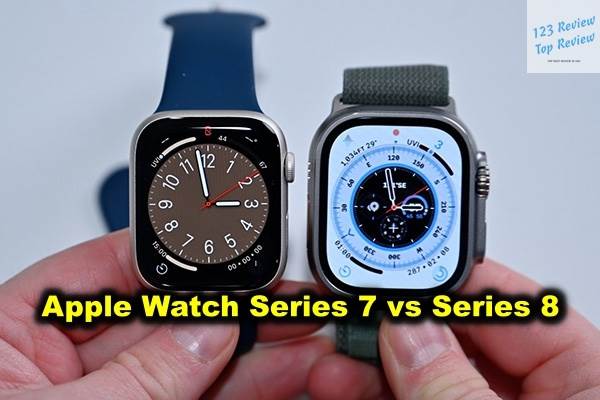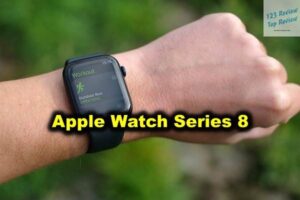The Apple Watch has long been a leader in the smartwatch industry, and with each new iteration, Apple continues to push the boundaries of what these devices can do. The Apple Watch Series 7 was a significant upgrade when it was introduced, but the Apple Watch Series 8 has since taken its place as the latest and most advanced model in Apple’s lineup. For those considering a new Apple Watch, the decision between the Series 7 and Series 8 can be challenging. This in-depth comparison will break down every aspect of these two models, from design and display to performance, health features, and value for money, helping you make an informed decision.
Design Comparison
Similarities in Design Elements
At first glance, the Apple Watch Series 7 and Series 8 look remarkably similar, which is a testament to Apple’s commitment to a consistent design language across its product lines. Both models feature the iconic rectangular shape with rounded corners that has become synonymous with the Apple Watch. The nearly edge-to-edge display, introduced with the Series 7, is carried over to the Series 8, offering users a larger screen area without increasing the overall size of the watch. The slim bezels on both models create an immersive experience, allowing the display to blend seamlessly into the watch’s case.

The Digital Crown, a signature feature of the Apple Watch, remains unchanged in its design and functionality across both models. Positioned on the side of the watch, it serves as the primary means of navigating through menus, zooming in on apps, and accessing the home screen. Below the Digital Crown, the side button remains in place, providing quick access to frequently used apps and features, such as Apple Pay, the dock, and emergency services.
Both the Series 7 and Series 8 offer water resistance up to 50 meters, making them suitable for swimming and other water-based activities. This durability ensures that users can wear their Apple Watch in various environments, whether they’re working out, swimming, or simply going about their daily routines. The consistency in these design elements reflects Apple’s focus on creating a product that is not only functional but also familiar and user-friendly.
Variations in Color Options
While the overall design language of the Apple Watch Series 7 and Series 8 is similar, Apple has made distinct choices regarding color options for each model, allowing users to express their personal style through their smartwatch.
The Series 7 was celebrated for its vibrant color palette, offering a wide range of hues that catered to different tastes. Colors like Midnight (a deep navy blue), Starlight (a subtle blend of silver and gold), Green, Blue, and the bold Product(RED) provided users with options that ranged from classic to eye-catching. These colors were designed to complement both casual and formal attire, making the Series 7 a versatile accessory.
In contrast, the Series 8 takes a slightly different approach, focusing on more refined and muted tones. Apple introduced new colors like Silver, Graphite, and a rich Deep Purple, which replaced some of the brighter options available in the Series 7. These colors are more understated, appealing to users who prefer a watch that blends seamlessly with a variety of outfits and occasions. The Deep Purple option, in particular, adds a touch of luxury and sophistication, making the Series 8 stand out in a subtle yet elegant way.
Case Material Differences
Apple has always offered its Apple Watch models in a variety of materials to cater to different preferences and needs. Both the Series 7 and Series 8 are available in three primary case materials: aluminum, stainless steel, and titanium. Each material offers a different balance of durability, weight, and aesthetics, allowing users to choose the one that best suits their lifestyle.
Aluminum: The aluminum cases for both models are lightweight and durable, making them ideal for everyday wear. Apple uses 100% recycled aluminum in these models, aligning with the company’s environmental goals. The aluminum models are also the most affordable, making them a popular choice for many users. The Series 8’s aluminum case is slightly more robust, with improved scratch resistance, ensuring that the watch can withstand the rigors of daily use. Stainless Steel: For those seeking a more premium feel, the stainless steel options offer a polished look and added durability. The stainless steel cases in both Series 7 and Series 8 are resistant to scratches and corrosion, making them a long-lasting choice. However, the Series 8’s stainless steel has been enhanced to be even more resistant to wear and tear, offering better protection against the elements and daily wear. Titanium: The titanium cases are the lightest and most durable of the three options, providing a perfect balance between strength and weight. Titanium is also hypoallergenic, making it an excellent choice for users with sensitive skin. The Series 8’s titanium case has been further refined, offering enhanced scratch resistance and a sleek brushed finish that adds to its premium appeal.
These material differences, while subtle, can influence a user’s decision, particularly if durability or weight is a significant consideration. The Series 8’s improvements in material strength and scratch resistance make it a more appealing choice for those who want a watch that can handle more demanding environments.
Display Features
Always-On Display Technology
The Always-On Retina display, introduced with the Apple Watch Series 5, has been a game-changer in the smartwatch industry. This feature allows users to glance at their watch and see the time, notifications, and other essential information without needing to raise their wrist or tap the screen. Both the Series 7 and Series 8 continue this tradition, offering an always-on display that is both bright and power-efficient.
In terms of brightness, both models perform exceptionally well, with the display remaining easy to read in various lighting conditions, from direct sunlight to dim indoor environments. However, the Series 8 introduces a subtle enhancement in low-light conditions, offering a slightly brighter display when the ambient light is minimal. This improvement ensures that users can see their watch face clearly even in dark environments, such as theaters or at night.
The always-on display in both models also supports a wide range of watch faces, many of which are customizable with complications that provide quick access to information like weather, activity rings, and calendar events. The Series 8’s display is slightly more responsive, thanks to the new S8 chip, which allows for smoother animations and quicker updates to complications.
Screen Size and Resolution
One of the most noticeable upgrades in the Apple Watch Series 7 was the increase in screen size. The Series 7 introduced two new case sizes: 41mm and 45mm, offering larger displays without significantly increasing the overall size of the watch. The larger display area made it easier for users to interact with apps, read notifications, and view detailed metrics during workouts.
The Series 8 retains these screen sizes and the same resolution, ensuring that users continue to enjoy the benefits of a larger display. However, Apple has made minor refinements to the screen on the Series 8, improving color accuracy and clarity. The improved display on the Series 8 offers richer colors and sharper text, making it easier to read even small text and detailed images. This enhancement is particularly noticeable when viewing photos or using apps with complex interfaces.
The increase in screen size also allowed Apple to redesign the user interface in both the Series 7 and Series 8, optimizing it for the larger display. For example, buttons and icons are larger, making them easier to tap, and the keyboard for text input is more spacious, allowing for more accurate typing. These changes enhance the overall usability of the watch, making it more intuitive and user-friendly.
Durability and Protection Ratings
Durability is a crucial factor for any wearable device, and Apple has made significant strides in making the Apple Watch more resistant to damage. Both the Series 7 and Series 8 feature crack-resistant front crystals, which provide protection against accidental bumps and drops. The Series 7 was the first to introduce this tougher glass, making it the most durable Apple Watch at the time.
The Series 8 builds on this foundation with even better durability features. In addition to the crack-resistant front crystal, the Series 8 offers improved IP6X dust resistance, ensuring that the watch can withstand exposure to dust and other small particles. This rating is particularly beneficial for users who work in dusty environments or who enjoy outdoor activities like hiking or mountain biking.
Both models are also water-resistant up to 50 meters, making them suitable for swimming and other water-based activities. However, the Series 8’s enhanced durability features, including its improved dust resistance and stronger materials, make it a more robust choice for those who need a watch that can handle more challenging conditions.
Health and Fitness Tracking
Heart Rate Monitoring Capabilities
Heart rate monitoring is one of the core features of the Apple Watch, and both the Series 7 and Series 8 excel in this area. The optical heart rate sensors in both models provide accurate readings for both resting and active heart rates, allowing users to monitor their cardiovascular health in real-time.
The Series 7 introduced a more advanced sensor that could detect irregular heart rhythms, which could be an indicator of atrial fibrillation (AFib). This feature, combined with the ability to monitor heart rate during workouts, made the Series 7 a powerful tool for fitness enthusiasts and those concerned about their heart health.
The Series 8 takes this a step further with algorithmic improvements that offer even more precise tracking. These improvements are particularly noticeable during high-intensity workouts, where the heart rate can fluctuate rapidly. The Series 8’s enhanced sensor can provide more consistent readings, giving users more accurate data to analyze their fitness progress and heart health.
Additionally, the Series 8 includes new heart rate zones, allowing users to monitor the intensity of their workouts more closely. These zones are personalized based on the user’s fitness level, providing more detailed feedback during activities like running, cycling, and high-intensity interval training (HIIT).
Blood Oxygen and ECG Sensors
The Blood Oxygen (SpO2) sensor and Electrocardiogram (ECG) app are two of the standout features introduced in previous Apple Watch models, and both the Series 7 and Series 8 continue to offer these critical health-monitoring tools.
The Blood Oxygen sensor measures the oxygen saturation in the user’s blood, providing insights into their respiratory and overall health. This feature is particularly useful for those with respiratory conditions, athletes training at high altitudes, or anyone interested in monitoring their oxygen levels during sleep. The Series 8 introduces slight enhancements to the SpO2 sensor, offering faster readings and improved accuracy, especially in lower oxygen environments.
The ECG app, available on both models, allows users to take an electrocardiogram at any time by simply placing their finger on the Digital Crown. The ECG can detect signs of atrial fibrillation, a potentially serious heart condition, and provide a PDF of the results that can be shared with healthcare providers. The Series 8’s ECG capabilities are identical to those of the Series 7, but the new algorithms in the Series 8 improve the accuracy and reliability of the readings.
New Temperature Sensing in Series 8
One of the most significant new features in the Apple Watch Series 8 is the temperature sensor, a tool that adds a new dimension to the watch’s health-tracking capabilities. The temperature sensor continuously monitors the user’s wrist temperature, providing valuable data that can be used to track changes in the body, such as those related to menstrual cycles or potential illness.
The temperature sensor is particularly useful for women, as it can help predict ovulation and provide more accurate menstrual cycle tracking. This feature can be especially beneficial for those trying to conceive or for anyone looking to gain more insights into their reproductive health.
The temperature sensor also works in conjunction with the Sleep app, offering users a more detailed analysis of their sleep patterns. By monitoring temperature changes throughout the night, the Series 8 can provide deeper insights into sleep quality, helping users understand how their body responds to different sleep conditions.
Safety Features
Crash Detection Technology in Series 8
Apple has always been at the forefront of integrating safety features into its products, and the Series 8 introduces a groundbreaking addition with Crash Detection technology. This feature uses advanced sensors and algorithms to detect when the wearer has been involved in a severe car crash. If a crash is detected, the watch automatically contacts emergency services and sends the user’s location to designated contacts.
Crash Detection is made possible by a combination of accelerometer, gyroscope, and GPS data, all of which work together to identify the force of impact and other factors indicative of a crash. This feature is particularly valuable for drivers who may not be able to call for help themselves after an accident. The Series 8’s ability to detect crashes accurately and quickly makes it a potentially life-saving feature, setting it apart from the Series 7.
Fall Detection Consistency
Fall Detection is another critical safety feature that has been a part of the Apple Watch since the Series 4. Both the Series 7 and Series 8 offer this feature, which uses the watch’s accelerometer and gyroscope to detect when the wearer has taken a hard fall. If the watch detects a fall, it prompts the user to respond. If the user does not respond within a certain time frame, the watch automatically contacts emergency services.
The Series 7 was already highly regarded for its accurate Fall Detection, which has helped countless users get the help they need after an accident. The Series 8 builds on this with minor algorithmic improvements that reduce false positives and improve detection accuracy, especially during activities where sudden movements or impacts might occur, such as skiing or biking.
Emergency SOS Functionality
The Emergency SOS feature is a critical safety tool available on both the Series 7 and Series 8. By holding down the side button, users can quickly contact emergency services and send their location to preselected contacts. This feature is invaluable in situations where immediate assistance is needed, such as during a medical emergency or if the user feels unsafe.
The Series 8’s Emergency SOS functionality remains consistent with the Series 7, providing the same reliable access to emergency services. However, with the improved sensors and algorithms in the Series 8, the watch can more accurately assess the user’s situation and determine when to trigger an emergency alert, adding an extra layer of security.
Performance Specifications
Processor Comparison: S7 vs S8 Chip
Performance is a critical aspect of any smartwatch, and the processor plays a significant role in determining how smoothly the device runs. The Apple Watch Series 7 is powered by the S7 chip, which was a considerable upgrade at the time of its release, offering faster app loading times, smoother animations, and more efficient power management.
The Series 8 takes performance to the next level with the introduction of the S8 chip. While the S8 chip shares some similarities with its predecessor, it brings several improvements that enhance the overall user experience. The S8 chip offers faster processing speeds, which translate to quicker app launches, smoother transitions between screens, and more responsive touch interactions. These improvements are particularly noticeable when using more demanding apps or features, such as fitness tracking, navigation, and on-device Siri.
The S8 chip also introduces improved power efficiency, which helps extend battery life and reduce energy consumption during intensive tasks. This efficiency is crucial for users who rely on their Apple Watch throughout the day, as it ensures that the watch can handle multiple tasks without draining the battery too quickly.
Battery Life Analysis
Battery life is a key consideration for any wearable device, and Apple has worked to optimize battery performance in both the Series 7 and Series 8. The Series 7 offers up to 18 hours of battery life on a single charge, which is sufficient for most users to get through a full day of use. This includes tracking workouts, receiving notifications, using apps, and monitoring health metrics.
The Series 8 maintains this 18-hour battery life but introduces a new Low Power Mode that can extend battery life even further. When enabled, Low Power Mode reduces the watch’s power consumption by limiting certain features, such as background heart rate monitoring and the always-on display. This mode is particularly useful for users who need to conserve battery life during extended periods away from a charger, such as when traveling or during long outdoor activities.
The Series 8 also offers faster charging capabilities, allowing the watch to reach 80% charge in just 45 minutes. This is a significant improvement over the Series 7, which also offered fast charging but at a slightly slower rate. The ability to quickly recharge the watch is a valuable feature for users who are always on the go and need to top up their battery quickly before heading out.
Charging Capabilities: Fast Charging and Low Power Mode
Fast charging was one of the standout features of the Apple Watch Series 7, allowing users to quickly top up their battery when time was limited. The Series 7 could reach 80% charge in approximately 45 minutes, making it easy to recharge the watch during short breaks throughout the day. This feature was particularly beneficial for users who track their sleep, as they could charge the watch in the morning or evening and still have enough battery for overnight monitoring.
The Series 8 builds on this fast-charging capability, offering the same charging speed but with improved efficiency. The Series 8’s charging system is more refined, ensuring that the watch charges faster while maintaining battery health. This means that even with frequent fast charging, the battery life and longevity of the Series 8 are preserved.
The new Low Power Mode in the Series 8 is another significant addition, providing users with more control over their watch’s battery life. When enabled, Low Power Mode disables certain features that consume more power, such as the always-on display and background heart rate monitoring. However, essential features like notifications and activity tracking remain active, ensuring that users still have access to the most important functions. This mode can extend the battery life to up to 36 hours, making it ideal for situations where charging is not possible.
Software and Features
watchOS Compatibility
Both the Apple Watch Series 7 and Series 8 are fully compatible with the latest version of watchOS, Apple’s operating system for its smartwatches. WatchOS is known for its intuitive interface, rich ecosystem of apps, and seamless integration with other Apple devices, such as the iPhone, iPad, and Mac.
WatchOS 9, the latest version, brings several new features and enhancements that are available on both the Series 7 and Series 8. These include new watch faces, updated workout tracking capabilities, and enhanced health metrics. For example, the new Medications app allows users to track their medication intake, set reminders, and log doses directly from their watch. The Sleep app has also been updated with more detailed sleep tracking, including new metrics like REM sleep and sleep duration.
One of the key advantages of watchOS is its backward compatibility, meaning that both the Series 7 and Series 8 will continue to receive software updates and new features for years to come. This ensures that users can enjoy the latest innovations and improvements without needing to upgrade their hardware frequently.
Unique Features of Series 8
While both the Series 7 and Series 8 offer a robust set of features, the Series 8 introduces several unique capabilities that set it apart from its predecessor. These features are designed to enhance the user experience and provide more advanced health and safety monitoring.
Crash Detection: As mentioned earlier, Crash Detection is one of the most significant new features of the Series 8. This feature uses advanced sensors and algorithms to detect severe car crashes and automatically contact emergency services. It is a potentially life-saving addition that provides peace of mind for drivers and their loved ones. Temperature Sensing: The new temperature sensor in the Series 8 adds a valuable tool for tracking body temperature changes. This feature is particularly beneficial for women, as it can help predict ovulation and provide more accurate menstrual cycle tracking. The temperature sensor also works in conjunction with the Sleep app, offering more detailed insights into sleep patterns and quality. Improved Durability: The Series 8 also boasts enhanced durability features, including a more crack-resistant front crystal and improved water resistance. These improvements make the Series 8 more resilient to everyday wear and tear, ensuring that it can withstand the rigors of an active lifestyle. Low Power Mode: The introduction of Low Power Mode in the Series 8 is another unique feature that extends battery life by disabling certain power-hungry functions. This mode is ideal for users who need their watch to last longer without sacrificing essential features like notifications and activity tracking.
Conclusion
The Apple Watch Series 7 and Series 8 are both outstanding smartwatches, offering a wide range of features designed to enhance the user’s health, safety, and overall experience. The Series 7 set a high standard with its larger display, fast charging, and robust health-monitoring tools, making it a popular choice among Apple Watch users.
The Series 8 builds on this foundation with several key enhancements, including the introduction of Crash Detection, a new temperature sensor, and Low Power Mode. These features, combined with the improved performance of the S8 chip and the continued excellence in health and safety tracking, make the Series 8 a compelling upgrade for those looking to invest in a new smartwatch.
For users who already own a Series 7, the decision to upgrade may come down to how much value they place on the new features, such as Crash Detection and temperature sensing. However, for those new to the Apple Watch or coming from an older model, the Series 8 represents the best of what Apple has to offer, providing a powerful and versatile smartwatch that can meet the demands of a modern lifestyle.





